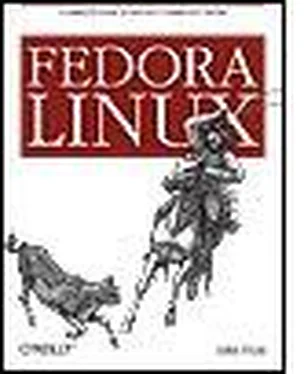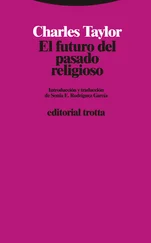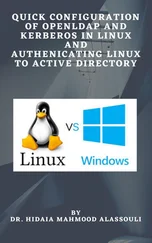Fedora Core can be configured for dual booting , as long as you have sufficient disk space for both operating systems. You will be given the opportunity to select the default operating system during the Fedora installation, and you can override this default during the boot process, selecting the operating system you wish to use from a menu.
If Windows is currently using your entire hard disk, you will need to resize the Windows partition (see Lab 10.1, "Resizing a Windows Partition ") or add an extra disk drive. If Windows is not yet installed on your computer, you should install it before Fedora; otherwise, it may overwrite your Fedora bootloader (or, in some cases, the entire Fedora installation).
1.1.3.2. ...other Linux distributions?
There are dozens and dozens of Linux distributions, each aimed at a different audience. For details about specific distributions, visit http://distrowatch.com .
1.1.3.3. ...seeing a list of the software packages included in Fedora Core?
Visit http://download.fedora.redhat.com/pub/fedora/linux/core/6/i386/os/repodata/ , and you'll see a browsable display of all of the packages in Fedora Core. Click on a package name to see a detailed description of the package.
1.1.4. Where Can I Learn More?
The Fedora Project: http://fedora.redhat.com/ and http://fedoraproject.org
The Fedora Legacy Project: http://www.fedoralegacy.org/
The Open Source Initiative: http://www.opensource.org/
About Fedora: http://fedora.redhat.com/About
Red Hat Enterprise Linux: http://redhat.com/rhel
CentOS: http://www.centos.org/
Linux distributions: http://distrowatch.com/
1.2. Obtaining Fedora Core Software
The Fedora software exists in two parts: Fedora Core , a Linux distribution that includes base applications for desktop and server systems, and Fedora Extras , a repository of additional applications that can be added easily to a Fedora Core system.
The first step is to obtain a copy of the Fedora Core software itself.
The Fedora Core installer is a bare-bones configuration of Linux designed specifically for the installation process. Once the installer is running, it configures and installs the Fedora Core software on your system.
There are, therefore, two parts to the software: the software used to boot up the system for the installation session, and the software that is installed on your system. These may be on the same media, or they may be separated into boot media and installation media .
1.2.1.1. Determining your architecture
Before selecting the media and obtaining the software, you must determine which architecture (machine type) you are using. Fedora Core is available for three different architectures:
i386
All Intel-compatible 32-bit systems with a standard BIOS, including all Intel 32-bit Celeron, Pentium, Centrino, and Core systems; AMD 32-bit Athlon, Duron, and Turion systems; and VIA CPUs such as the C3 and Eden processors. Older processors such as 80386, 80486, and K6 processors will also work. Fedora Core may be installed on Apple Mac systems with an Intel processor by using Apple's Boot Camp software (included in Mac OS X 10.5 and available in beta form for Mac OS X 10.4).
x86_64
All AMD-compatible 64-bit systems, including Opteron, Athlon 64, Duron 64, and Turion 64 systems, and Intel 64-bit Pentium 4, Xeon, and Core 2 systems. These systems can also run the i386 version but will do so in 32-bit mode.
PPC
Systems based on the PowerPC G3/POWER4 and later PowerPC processors, including recent PPC-based Apple Macs (manufactured between 1999 and 2006), IBM eServer pSeries, and IBM RS/6000 systems.
This chapter focuses on the i386 and x86_64 platforms, but the PPC installation procedure is quite similar.
1.2.1.2. Choosing boot and installation media
The Fedora Core installation boot software is usually started from a CD or DVD disc. It's also possible to boot from a USB flash disk drive if the system's BIOS supports it, or to boot from a network boot server using the PXE protocol. Table 1-1 outlines the boot media requirements.
Table 1-1. Boot media requirements for installing Fedora Core 6
| Media type |
Media count |
Size |
Notes |
| DVD |
1 |
4.7 GB (or larger) |
All of the software will fit on one disc (which serves as both the boot and installation medium), so this is usually the fastest and most convenient installation option. |
| CD |
1 |
8 MB (any CD) |
A single CD or mini-CD can be used to start a network or hard disk installation. If you will be using CDs for both the boot and installation media, five 700 MB discs are required (see Table 1-2). |
| USB flash drive |
1 |
8 MB or higher |
Requires a Linux system to configure the drive. Useful for network or hard disk installation. The BIOS of some systems will not permit booting from a USB flash key (beware of BIOS versions that permit booting only from a USB floppy or Zip drive). |
| PXE Server (Network Boot) |
1 |
6.5 MB |
Requires an existing system to serve as the PXE server (see Lab 10.3, "Preparing Alternate Installation Media"). |
Once the system has been booted, the rest of the installation software can be on a DVD, several CDs, an existing hard drive partition on the computer (or an external hard disk drive), or an FTP, NFS, or HTTP server. Table 1-2 outlines the requirements.
Table 1-2. Installation media requirements for Fedora Core 6
| Media type |
Media count |
Size |
Notes |
| DVD |
1 |
4.7 GB or higher |
Same media used for booting. |
| CD |
5 |
700 MB |
The images will not fit on 650 MB discs, such as some CD-RWs or old CD-Rs. |
| Network server (HTTP, NFS, or FTP) |
1 |
3.5 GB of disk space on the server |
HTTP is the lightest of the three protocols and is often the easiest to set up. |
| Hard disk partition |
1 |
3.5 GB of disk space |
Only ext2 and ext3 (Linux) and FAT (Windows/DOS) partitions are supported, on an internal or external disk drive. NTFS and LVM-based partitions will not work. This option is useful when adding Fedora to a computer that already has an operating system installed; the existing OS can be used to download the installation images. Note that the file size exceeds the maximum for FAT16 filesystems (2 GB). |
1.2.1.3. Creating Fedora Core CDs or DVDs
To create a Fedora Core CD or DVD set, you must obtain the ISO image files .
To download the entire Fedora Core distribution for installation direct from disc, use one of these two procedures:
Go to the web page http://fedora.redhat.com/Download/mirrors.html and select an HTTP or FTP site for direct download. Select the directory for the desired Fedora Core version number (6), then the directory for your machine architecture (i386, PPC, or x86_64), and then select the iso directory. You will probably not need the files containing "SRPM" in the name. If you want the CD images, get the files containing "disc1," "disc2," and so forth in the name; to obtain the DVD image, get the file containing "DVD" in the name.
Use BitTorrent ( http://www.bittorrent.com ) to obtain the files from one of the Fedora torrents listed on http://torrent.fedoraproject.org/ .
Читать дальше












